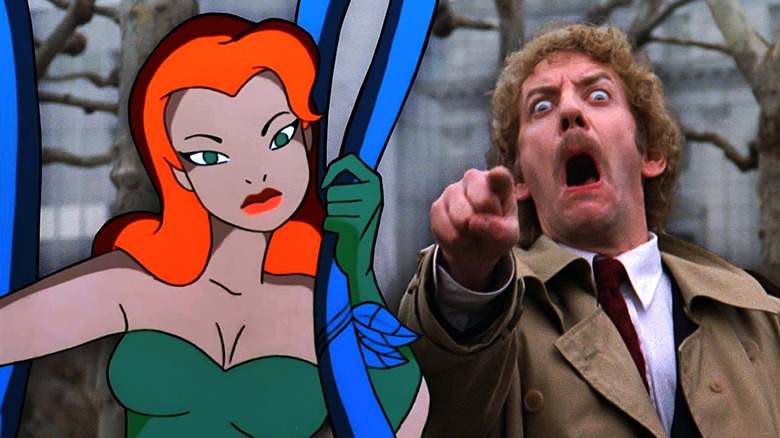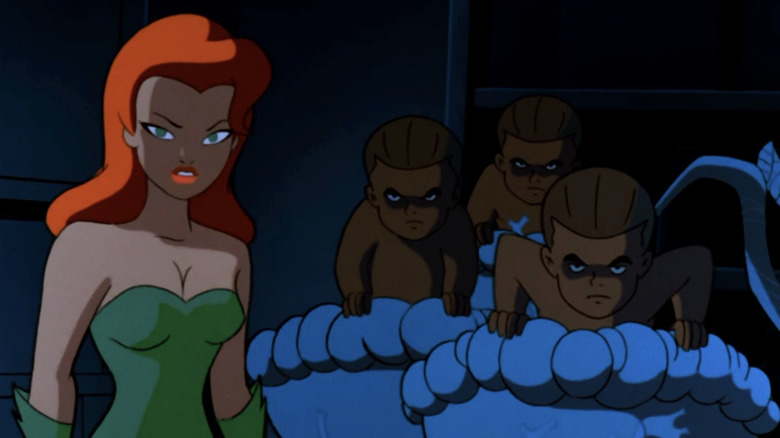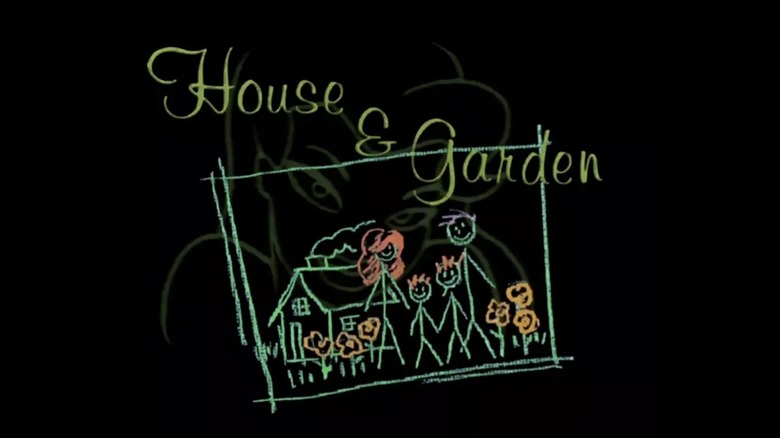One Of The Best Batman Episodes Was A Homage To Invasion Of The Body Snatchers
Batman famously has one of the best rogues' galleries in American superhero comics. But even among that stunning ensemble, writers do play favorites. You can definitely tell, watching the superlative "Batman: The Animated Series," that plant-controlling femme fatale eco-terrorist Poison Ivy (Diane Pershing) was one of the show's preferred villains.
Poison Ivy was one of the first villains to appear in "The Animated Series," debuting in episode 5, "Pretty Poison." The show gave Ivy a partner-in-crime with Harley Quinn (Arleen Sorkin), establishing a friendship (and ultimately romance) that's lasted 30 years. Ivy also got major supporting parts in villain team-up episodes, "Almost Got 'Im" (where Gotham's worst play poker and swap stories about fighting Batman) and "Trial" (where Arkham inmates start running the asylum). In the series' final run of episodes, Ivy even got a dedicated farewell episode: "House & Garden" (written by Paul Dini). As the title suggests, Ivy seemingly reforms for a quiet life as a wife, mother, and homemaker in the Gotham suburbs.
That's not to say this heavy focus on Ivy was a problem. She's one of the show's most memorable villains, and not just because she appeared a lot. Nowadays, thanks to her environmentalist side and queer romance with Harley, a lot of writers hold back and keep Ivy from being too bad. Not in this show! Pershing's Ivy was as venomous as the villainess should be. If her plant theme sounds one-note, "Batman: The Animated Series" proved she could sustain a variety of stories.
"House & Garden" especially is one of my personal favorite "Batman" episodes because it's also one of the series' creepiest. The episode's denouement is right out of "Invasion of the Body Snatchers," because Ivy upgrades from mind-controlling people with plant spores to creating people from plants.
Batman's House & Garden features Poison Ivy growing Pod People
"Invasion of the Body Snatchers" is one of the most famous science-fiction horror films out there. It has been remade many times, both in spirit and under that exact name. The two most famous versions, though, are the original 1956 film (directed by Don Siegel) and the even better 1978 "Body Snatchers" remake (by Philip Kaufman). Both versions use the same concept for the invaders: plant-based alien lifeforms that absorb human DNA. The plants first manifest as pods, which grow emotionless replicas of a person as they sleep. The original human then crumbles into waste as the body snatcher takes their place. That life-cycle has led to a nickname for the invaders: "Pod People."
The fundamental premise, of an invading force infiltrating a community in a familiar face, will never get old. Siegel's original is set in suburban Orange County, California, and to this day, people debate if it's a parable about suburban conformity or a Red Scare panic picture about communist infiltration.
The Kaufman film moves the invasion to San Francisco, making it more about urban isolation. People have gotten away from the sorts of communities seen in the original "Invasion," and the Pods are there to forcibly restore it. The 1993 Abel Ferrara-directed "Body Snatchers" (less well-known than the first two but still good) is set on a military base and critiques how much militarism has seeped into American life.
"House & Garden" hews closest to the Siegel "Body Snatchers," with a theme of something wrong in suburbia. Gotham's wealthiest bachelors are being poisoned and robbed. The culprits are plant monsters that look like the Incredible Hulk mixed with a cactus. Their master must be Poison Ivy, Batman (Kevin Conroy) thinks, but she's reformed. Ivy has married her former doctor Steven Carlyle (Peter Strauss), adopted his sons Chris and Kelly, and seems quite happy in her new life.
The truth turns out to be in the middle — Ivy has happily settled down, but she's far from changed. Her "family" are actually plant-based facsimiles, and she keeps the real Dr. Carlyle bound in her basement lab. She uses his DNA as material to "grow" plant-human hybrids; babies sprout from cabbage-like pods, age rapidly into kids ("Chris and Kelly") and then adult men (the "Dr. Carlyle" Ivy has been playing house with). Their final forms are those grotesque plant monsters.
Now, Ivy has only "body-snatched" a single man for her scheme, which is hardly an invasion. But the imagery of human beings birthed from plant pods has to be an "Body Snatchers" homage. The plants taking turns at impersonating Dr. Carlyle, their genetic donor, is also exactly what "Body Snatchers" is about.
House & Garden is a horror story set in Batman's world
"Batman: The Animated Series" mostly based itself on film noir. Batman is a pulp adventurer and detective, so while Gotham is a city of shadows, the atmosphere is more mysterious than horrifying. Usually.
Some "Batman" episodes dove straight into horror. "Feat of Clay," introducing Matt Hagen/Clayface (Ron Perlman), used the villain's transformation for a body horror story. "See No Evil" was a straight riff on "The Invisible Man," the way "House & Garden" is on "Body Snatchers." In "Moon of the Wolf," Batman fights a werewolf (but censors thought a vampire episode would be too much).
The third act of "House & Garden" is as unsettling as "Batman" ever got. Batman and Robin descend into Ivy's underground lab. In the darkness, they find the real Dr. Carlyle and then hear Ivy's freshly-sprouted spawn crying for their mommy the way any normal baby does. As the babies crawl out of the pods, even Batman's calm breaks. Ivy's maternal affection for her creations and simultaneous use of them as disposable cannon fodder shows how warped she is, as does the fact that she considers this a "normal" life.
Batman ultimately uses (what else?) weedkiller to destroy the pod spawn — including, it turns out, the Poison Ivy before him, who melts in his arms. The real Ivy, sensing Batman was onto her, is flying away from Gotham and weeping over a photo album of her "family memories."
That was the last we saw of Ivy in the original 85 episode run of "Batman." When the show returned in 1997 as "New Batman Adventures," though, it couldn't leave Ivy out. Her main episode in that season, "Chemistry," builds on "House & Garden." This time, she creates dozens of plant simulacrums to act as perfect partners for Gotham's wealthiest singles — Bruce Wayne included — so she can do a mass black widow scheme. Ivy's pod people in "Chemistry" aren't replacing any genuine humans, but it is still an invasion of faux-people.
The next Batman cartoon, 2004's "The Batman," introduced Ivy (Piera Coppola) in season 3. Her second appearance, "Fleurs du Mal," did the clearest homage to "Invasion of the Body Snatchers" yet. Ivy abducts important Gotham officials like Commissioner Gordon and replaces them with plant replicas, allowing her to bend the city to her whims. Ivy's ultimate ambition, like the Pod People, is exponential growth and replacement across all of Gotham. Unlike the Pod People, though, Ivy at least keeps the originals alive, allowing Batman (Rino Romano) and Batgirl (Danielle Judovits) to rescue them. (Though along the way, they have to fight plant clones of themselves.)
Like the Body Snatchers, Poison Ivy walks the line between human and sapient plant. She regards plants as people more than she does humans, so of course she experiments to imbue plants with anthropomorphism. The sights of her living biotech inspires the exact same chills as the Pod People in "Body Snatchers" do, so using the movie as a reference point for several Poison Ivy stories is an all-natural choice.


